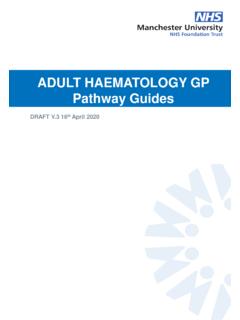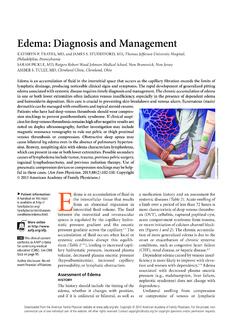Transcription of GnRH analogue injections - University Hospital of South ...
1 TIG 71/19 Updated: November 2019 Review: November 2021 Page 1 of 4 Saint Mary s Hospital Gynaecology Services Information for Patients gnrh analogue injections Why have I been offered these injections ? Gonadotrophin-releasing hormone ( gnrh ) analogue injections are used for the management of numerous gynaecological conditions including: Endometriosis Uterine fibroids Adenomyosis Menorrhagia Pelvic pain Severe premenstrual syndrome The injections are also used to treat prostate cancer in men. Occasionally your consultant gynaecologist may start you on these injections for other medical reasons.
2 The overall aim of these injections is to improve symptom management by reducing or ultimately stopping heavy menstrual bleeding, whilst managing the associated symptoms of pelvic pain which will hopefully improve your quality of life. The injections may be started prior to surgery as part of surgical preparation or you may have opted for medical management to avoid complicated gynaecology surgery. The reasons differ depending on your condition, but this will be discussed in depth at your consultation. Types of injections available and how they are given? The commonly used injections we use are Prostap and Zoladex.
3 Both of these injections are gnrh analogues and drugs are only available in injection form. Prostap is administered via the intramuscular or subcutaneous route. Due to drug volume we generally give the injection in the buttock as this tends to be the largest muscle. TIG 71/19 Updated: November 2019 Review: November 2021 Page 2 of 4 Zoladex is only given via the subcutaneous route (top layer of fatty tissue) of the abdomen. Zoladex is a small capsule so it is normal to feel a small lump under the injection site once the injection has been given. How do these injections work?
4 Both injections work in the same way. The medication is a synthetic hormone which is used to reduce the levels of oestrogen in the body. It is also used to treat prostate cancer in men by reducing levels of testosterone. It affects the release of hormones from the pituitary gland (luteinizing hormone and follicle stimulating hormone), these hormones stimulate the release of oestrogen and progesterone from the ovaries. When the medication is first administered, there is an initial increase in circulating hormones and an initial flare up response is caused. Patients may notice a flare up of symptoms associated with their gynaecological condition, this should only last for the first two weeks of treatment.
5 Ongoing treatment will however cause a reduction of circulating hormones resulting in reduced oestrogen levels which prevent ovulation and in turn cause a medically induced menopause. This menopausal state (anovulation) deprives the endometrial deposits from oestrogen aiming to stop menstrual periods and reduce the associated pelvic pain. Most women will stop bleeding and notice an improvement to symptoms within two months of starting treatment once hormone levels have reduced to a stabilised level. What are the side effects? The majority of the side effects are related to decreased oestrogen levels and are similar to the side effects associated with menopause, such as hot flushes, mood swings, depression and vaginal dryness.
6 gnrh injections may also increase the risk of osteoporosis and vaginal bleeding may occur during treatment. Blood sugar levels may be altered during treatment with gnrh analogues, which may affect control in diabetic patients and require more frequent monitoring of blood glucose. Please attend your nearest A&E department if you develop a severe rash, severe itching, shortness of breath or difficulty breathing. Although these are rare, these could be symptoms of a severe allergic reaction. Very common (may affect more than 1 in 10 people) Difficulty sleeping, headaches or hot flushes.
7 Common (may affect up to 1 in 10 people) Weight changes, mood changes, depression, tingling in hands or feet, dizziness, nausea, joint pain, muscle weakness, breast tenderness, changes in breast size, vaginal dryness, swelling in ankles or skin reactions at the injection site (these include skin hardening, redness, pain, abscesses, swelling, nodules, ulcers and skin damage). TIG 71/19 Updated: November 2019 Review: November 2021 Page 3 of 4 Uncommon (may affect more than 1 in 100 people) Loss of appetite, changes in blood lipids (cholesterol), altered vision, pounding heartbeats, diarrhoea, vomiting, abnormalities in liver blood tests, hair loss, muscle aches, fever, chills or tiredness.
8 If you experience any side effects, then please inform a member of your Gynaecology team. How can these side effects be managed? As the side effects of gnrh are mainly associated with low oestrogen levels, symptoms can be managed with the use of Hormone Replacement Therapy (HRT). HRT is usually given alongside gnrh injections to prevent or reduce the associated side effects associated with menopause making treatment more tolerable. A low dose of oestrogen such as Tibolone is usually the first line HRT medication offered and one tablet should be taken per day (at the same time). If the HRT prescribed is not effective in managing your side effects, then other HRT medications can be offered.
9 The doses of oestrogen used are small so they will not reduce the effectiveness of the gnrh analogue injection . The most serious side effect of gnrh analogue treatment is thinning of the bones (osteoporosis). If injections are administered alone then this risk increases and treatment can only be provided for 6 months. The use of HRT have long-term benefits in reducing bone thinning and associated risk of osteoporosis. Where gnrh analogue treatment is provided for long term management a bone density scan (DEXA scan Dual Energy X-ray Absorptiometry) will be carried out after 2 years of treatment to ensure bone density is within the normal range.
10 A 6-month treatment break will also be recommended at this time. How often will I need them? For both Prostap and Zoladex there are two doses available: Prostap (4 weekly) Prostap (12 weekly) Zoladex (4 weekly) Zoladex (12 weekly) The dose administered depends on how long the drug is effective, your doctor or nurse will inform you of which dose you have received and when you are next due an injection . If you are only receiving the injection as a one off ( in preparation for theatre) you may not need to have further injections . However, if you and your practitioner have planned for continuous management of gnrh injections over a period of time, you will need to attend injection clinics on either a 4 weekly or 12 weekly basis.

















